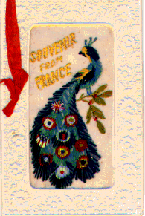
To learn more about postcards in World I and this aspect of popular culture, see John Laffen, World War I in Postcards (1988), Jack Smith, Military Postcards: 1870 to 1945 (1988), and George Mosse, Fallen Soldiers, Chapter 7, "The Process of Trivialization" (1990). George Mosse, as the title of his chapter suggests, thinks that postcards like this, published by Bamforth as #37 in a series called "Affectionate Soldier Greetings," trivialized the experiences at the front with religious, mawkish and escapist sentiments. John Ellis, the author of Eye-Deep in Hell (1989), says that postcards allowed the soldiers at the front to reassure and comfort worried relatives and friends at home. "Postcards," he says, "were much more common than letters," and the very use of trite cliches was an attempt to reduce the war to the same predictable and rather trivial routine that governed ordinary life back home" (139-40).

This is an embroidered "silk" from World War I, and these beautiful cards are an extreme example of a way to escape the ugliness of war at the front and to send home a miniature piece of hand-crafted art. The card has a red ribbon decorating it, and in the tail of the bird is embroidered with the colors of the various flags of the Allies. The message, also embroidered, is "Souvenir from France." The card is inscribed "To Dollie" from "Walter" and dated May 18, 1918. These cards were relatively expensive--they were, after all, embroidered by hand--and popular mementos to send home from the Front. The messages on them are often poignant and tell us how much the men at the Front missed their loved ones.
John Laffen's comments on embroidered postcards


